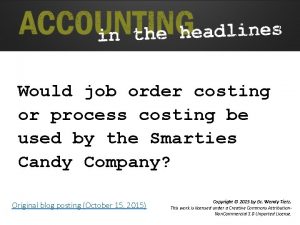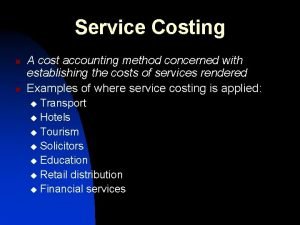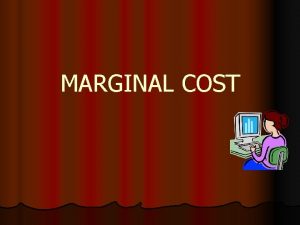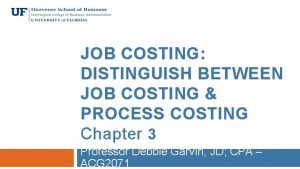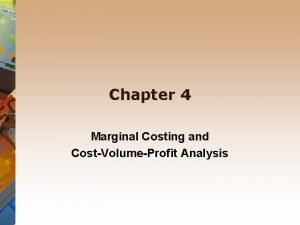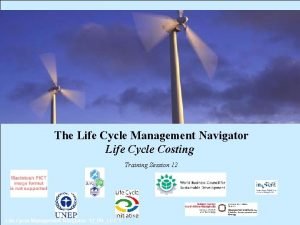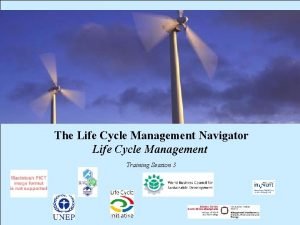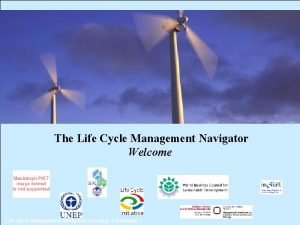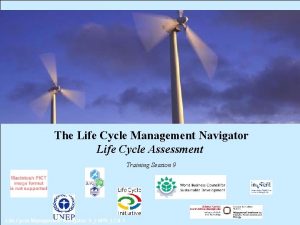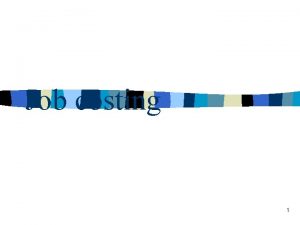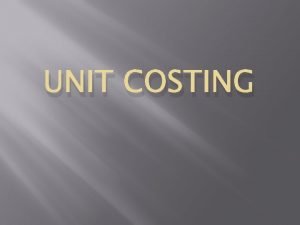The Life Cycle Management Navigator Life Cycle Costing









- Slides: 9

The Life Cycle Management Navigator Life Cycle Costing Training Session 12 Life Cycle Management Navigator: 12_EXPR_LCC 1 CSCP, UNEP, WBCSD, WI, In. WEnt, UEAP ME

Life Cycle Costing Exercise Setting the Scene The original cost accounting system of “Silla Manufacturing Co. ” provides the following data. Costs � Procurement costs Costs for storage, handling, processing, collecting etc. Disposal costs Costs 500, 000 485, 000 1, 000 “Disposal costs” = 1. 5% of total costs Life Cycle Management Navigator: 12_EXPR_LCC 2 CSCP, UNEP, WBCSD, WI, In. WEnt, UEAP ME

Life Cycle Costing Exercise Question 1 According to the original accounting system of “Silla Manufacturing Co. ” life cycle costs (here: disposal costs) add up to 1. 5% of total costs. • How would you as a manager of “Silla Manufacturing Co. ” evaluate the situation? • Does life cycle cost reduction seem attractive to you? Life Cycle Management Navigator: 12_EXPR_LCC 3 CSCP, UNEP, WBCSD, WI, In. WEnt, UEAP ME

Life Cycle Costing What is Non-Product Output (NPO)? Exercise Examples for NPO: • Solid waste • Waste water • Heat losses • Emissions to air Life Cycle Management Navigator: 12_EXPR_LCC 4 CSCP, UNEP, WBCSD, WI, In. WEnt, UEAP ME

Life Cycle Costing Changing the Scene Exercise “Silla Manufacturing Co. ” came to the conclusion that they need more transparency on their life cycle costs to take appropriate action. For this reason they screened their non-product output flows and allocated respective costs. The result looks as follows. . . Life Cycle Management Navigator: 12_EXPR_LCC 5 CSCP, UNEP, WBCSD, WI, In. WEnt, UEAP ME

Life Cycle Costing Exercise Extended Information Basis The revised accounting system provides the following data: Procurement costs Costs for storage, handling Costs for production process Costs for collecting Disposal costs Costs Product output 455, 000 125, 000 310, 000 -- -- 890, 000 Nonproduct output 45, 000 15, 000 23, 000 12, 000 15, 000 110, 000 Costs 500, 000 140, 000 333, 000 12, 000 15, 000 1, 000 � “Non-product output costs” = 11% of total costs Life Cycle Management Navigator: 12_EXPR_LCC 6 CSCP, UNEP, WBCSD, WI, In. WEnt, UEAP ME

Life Cycle Costing Exercise Question 2 Consider the more detailed information on life cycle costs. • How do you as a manager of “Silla Manufacturing Co. ” evaluate the situation now? • What measures could you propose to reduce environmental costs (here: nonproduct output costs)? Life Cycle Management Navigator: 12_EXPR_LCC 7 CSCP, UNEP, WBCSD, WI, In. WEnt, UEAP ME

Life Cycle Costing Exercise Findings The new transparency on NPO-flows and associated costs helped “Silla Manufacturing Co. ” to. . . • understand that NPO costs are about 7 times higher than costs for disposal (15, 000 => 111, 000); • recognise that NPO costs are a significant component of the costs structure (11% of total costs). � This motivated “Silla” to develop improvement measures. . . Life Cycle Management Navigator: 12_EXPR_LCC 8 CSCP, UNEP, WBCSD, WI, In. WEnt, UEAP ME

Life Cycle Costing New Opportunities Exercise Based on the better information basis “Silla Manufacturing Co. ” wa able to elaborate the following improvement measures: • Reduction of wood-NPO by. . . - improving cutting process; - reuse of wood-NPO as input for other products (wood NPO costs ca. 20% of unprocessed, “new” wood). • Substitution of adhesives, use of screws - In case of a defect/error, not longer does the whole product become NPO but just the defective part. • Additional measures to avoid “NPO production” at the end of the production process, because NPO costs accumulate from production step to production step. Life Cycle Management Navigator: 12_EXPR_LCC 9 CSCP, UNEP, WBCSD, WI, In. WEnt, UEAP ME
 Job order costing vs process costing
Job order costing vs process costing Job wr53 at nw fab
Job wr53 at nw fab Differences between service costing and product costing
Differences between service costing and product costing Absorption costing vs marginal costing
Absorption costing vs marginal costing Job order costing vs process costing
Job order costing vs process costing Differentiate between job costing and process costing
Differentiate between job costing and process costing Difference between job costing and contract costing
Difference between job costing and contract costing Variable costing vs absorption costing
Variable costing vs absorption costing Marginal costing vs variable costing
Marginal costing vs variable costing Advantages of activity based costing
Advantages of activity based costing
